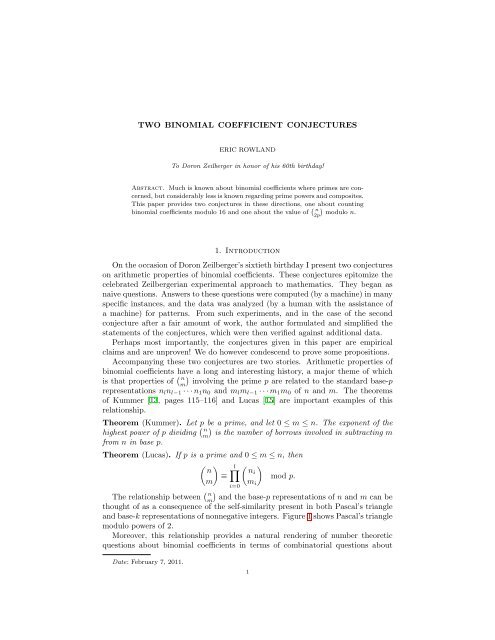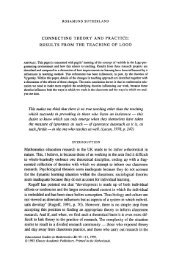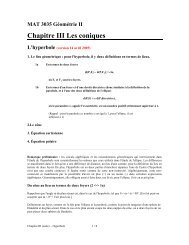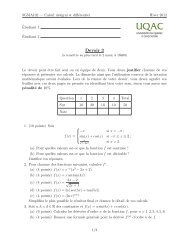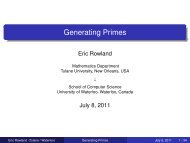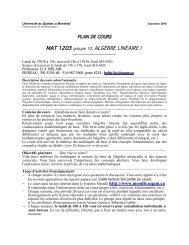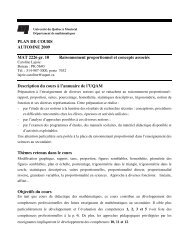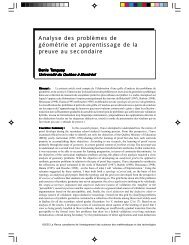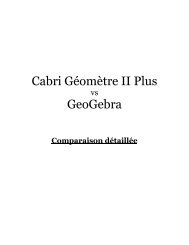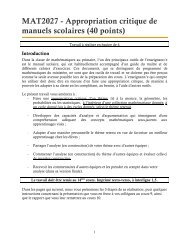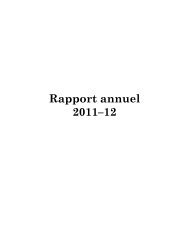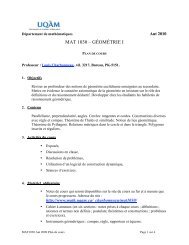TWO BINOMIAL COEFFICIENT CONJECTURES 1. Introduction On ...
TWO BINOMIAL COEFFICIENT CONJECTURES 1. Introduction On ...
TWO BINOMIAL COEFFICIENT CONJECTURES 1. Introduction On ...
Create successful ePaper yourself
Turn your PDF publications into a flip-book with our unique Google optimized e-Paper software.
<strong>TWO</strong> <strong>BINOMIAL</strong> <strong>COEFFICIENT</strong> <strong>CONJECTURES</strong>ERIC ROWLANDTo Doron Zeilberger in honor of his 60th birthday!Abstract. Much is known about binomial coefficients where primes are concerned,but considerably less is known regarding prime powers and composites.This paper provides two conjectures in these directions, one about countingbinomial coefficients modulo 16 and one about the value of ( n2p)modulo n.<strong>1.</strong> <strong>Introduction</strong><strong>On</strong> the occasion of Doron Zeilberger’s sixtieth birthday I present two conjectureson arithmetic properties of binomial coefficients. These conjectures epitomize thecelebrated Zeilbergerian experimental approach to mathematics. They began asnaive questions. Answers to these questions were computed (by a machine) in manyspecific instances, and the data was analyzed (by a human with the assistance ofa machine) for patterns. From such experiments, and in the case of the secondconjecture after a fair amount of work, the author formulated and simplified thestatements of the conjectures, which were then verified against additional data.Perhaps most importantly, the conjectures given in this paper are empiricalclaims and are unproven! We do however condescend to prove some propositions.Accompanying these two conjectures are two stories. Arithmetic properties ofbinomial coefficients have a long and interesting history, a major theme of whichis that properties of ( nm)involving the prime p are related to the standard base-prepresentations n l n l−1 · · · n 1 n 0 and m l m l−1 · · · m 1 m 0 of n and m. The theoremsof Kummer [13, pages 115–116] and Lucas [15] are important examples of thisrelationship.Theorem (Kummer). Let p be a prime, and let 0 ≤ m ≤ n. The exponent of thehighest power of p dividing ( nm)is the number of borrows involved in subtracting mfrom n in base p.Theorem (Lucas). If p is a prime and 0 ≤ m ≤ n, then( nl∏( )ni≡mod p.m)m ii=0The relationship between ( nm)and the base-p representations of n and m can bethought of as a consequence of the self-similarity present in both Pascal’s triangleand base-k representations of nonnegative integers. Figure 1 shows Pascal’s trianglemodulo powers of 2.Moreover, this relationship provides a natural rendering of number theoreticquestions about binomial coefficients in terms of combinatorial questions aboutDate: February 7, 201<strong>1.</strong>1
2 ERIC ROWLANDFigure <strong>1.</strong> Pascal’s triangle modulo 2 α for 1 ≤ α ≤ 6, in whichnested structure can be seen.words. We shall use the notation |n| w to denote the number of occurrences of theword w in the base-p representation n l n l−1 · · · n 1 n 0 , where p is the prime impliedby context.Both conjectures in the paper are concerned with the values of ( nm)modulo k.The first conjecture concerns counting binomial coefficients ( nm)equivalent to acertain residue class modulo 16, for fixed n. The second conjecture concerns thevalue of ( n2p)modulo n.2. Counting entries modulo kCounting binomial coefficients is a sort of “meta-combinatorics” — we are countingthe counters! <strong>On</strong>e basic question we can ask about Pascal’s triangle modulo kis how many nonzero entries there are on row n. This question was answered forprime k = p by Fine [5] and shown to be ∏ li=0 (n i + 1). For prime powers k = p αan expression was found by the author [16]. There has been no progress in the caseof composite k.Here we shall be interested in a refinement of the previous question: Let a k,r (n)be the number of integers 0 ≤ m ≤ n such that ( nm)≡ r mod k; what is thestructure of a k,r (n)?The first result on a k,r (n) was Glaisher’s 1899 [7] discovery that a 2,1 (n) = 2 |n|1 .After that there appears to have been no results until 1978, when Hexel andSachs [11, §5] determined a formula for a p,r i(n) for any prime p in terms of (p−1)throots of unity, where r is a primitive root modulo p. From this they derived( )a 3,1 (n) = 2 |n|1−1 · 3 |n|2 + 1( )a 3,2 (n) = 2 |n|1−1 · 3 |n|2 − 1
<strong>TWO</strong> <strong>BINOMIAL</strong> <strong>COEFFICIENT</strong> <strong>CONJECTURES</strong> 3as well as explicit formulas for a 5,r i(n) in terms of |n| 1 , |n| 2 , |n| 3 , and |n| 4 . Garfieldand Wilf [6] exhibited a method to compute the generating function ∑ p−2i=0 a p,r i(n)xi ,where again r is a primitive root.Recently, Amdeberhan and Stanley [2, Theorem 2.1] studied the number of coefficientsequal to r in the nth power of a general multivariate polynomial overa finite field, where r is an invertible element of the field. They showed that iff(x) ∈ F q [x 1 , . . . , x m ] then the number a(n) of coefficients in f(x) n equal to r ∈ F × qis a q-regular sequence, meaning that it satisfies linear recurrences in a(q e n + i) [1].The first results for a non-prime modulus were formulas for a 4,r (n) given byDavis and Webb [3]:a 4,1 (n) ={2 |n|1 if |n| 11 = 02 |n|1−1 otherwisea 4,2 (n) = 2 |n|1−1 · |n| 10{0 if |n| 11 = 0a 4,3 (n) =2 |n|1−1 otherwise(where |n| w counts occurrences of w in the base-2 representation of n). In particular,if r is odd then a 4,r (n) is either 0 or a power of 2.Granville observed that in a sense the statement that a 4,r (n) is either 0 or apower of 2 parallels Glaisher’s result that a 2,1 (n) = 2 |n|1 is (either 0 or) a powerof 2. Granville asked whether a similar statement is true modulo 8. His delightfulpaper “Zaphod Beeblebrox’s brain and the fifty-ninth row of Pascal’s triangle” [8]contains the following theorem.Theorem (Granville). If r is odd then a 8,r (n) is either 0 or a power of 2.As in the case of a 4,r (n), for even r other values occur. For example, a 8,4 (12) = 5and a 8,0 (16) = 12.Granville goes on to consider the number of binomial coefficients congruent to anodd residue class r modulo 16, and he discovers that the analogous statement failsfor n = 59! Granville writes: “Unbelievably, there are exactly six entries of Row59 in each of the congruence classes 1, 11, 13, and 15 (mod 16)! Our pattern hascome to an end, but not before providing us with some interesting mathematics, aswell as a couple of pleasant surprises.”But this isn’t the end of the story! We are now lead to ask: What values doesa 16,r (n) take for odd r? Explicit computation shows that up to row 2 20 the set ofvalues that occur is{0, 1, 2, 4, 6, 8, 12, 16, 20, 24, 32, 40, 48, 56, 64, 72, 80, 96, . . . , 65536}.This computation took nearly three CPU weeks to complete. It is clear that theonly odd number that occurs is 1, since ( )2nn is even for n ≥ 1, so a16,r (n) is even.But the data suggests that a 16,r (n) does not take on every even number.Conjecture <strong>1.</strong> Fix n and odd r.If a 16,r (n) is divisible by 3, then it is also divisible by 2.If a 16,r (n) is divisible by 5, then it is also divisible by 2 2 .If a 16,r (n) is divisible by 7, then it is also divisible by 2 3 .If a 16,r (n) is divisible by 11, then it is also divisible by 2 5 .
4 ERIC ROWLANDIf a 16,r (n) is divisible by 13, then it is also divisible by 2 6 .If a 16,r (n) is divisible by 17, then it is also divisible by 2 4 .If a 16,r (n) is divisible by 31, then it is also divisible by 2 5 .Moreover, these eight primes are the only primes that appear up to row 2 20 . Ofcourse, there is a probably a more general and more compact conjecture waiting tobe discovered. However, it is not clear what the corresponding powers of 2 mightbe for larger primes.Granville’s analysis of a 8,r (n) was long (and in fact incomplete [9, 12]). However,it should be possible to automate Granville’s work in true Zeilberger fashion.We do not undertake this work here, but once this is done and understood, themethodology will likely be applicable to a 16,r (n), and perhaps the statements inthe conjecture and the larger context surrounding them will become clear. Hopefullya reader will take up this challenge!3. The value of ( nm)modulo nWe all know the feeling of anxiety caused by witnessing a calculus student applythe “high school dream” 1 (a + b) n = a n + b n ,in which exponentiation distributes over addition. But of course the high schooldream ( is actually valid on occasion. In particular, (a + b) p ≡ a p + b p mod p, sincep)m ≡ 0 mod p for 1 ≤ m ≤ p − <strong>1.</strong>We might then ask: How badly does the high school dream fail for non-primes?What is ( nm)modulo n, and how frequently is it nonzero? With such an answer wecan precisely quantify how upset at students we are entitled to get!Rather than study ( )nm modulo n directly, we divide by n and consider frac(1 nn(m)),where frac(x) = x − ⌊x⌋ is the fractional part of x. We can recover the value of ( )nmmodulo n from ( )nm ≡ n frac(1 n)n(m ) mod n. Figure 2 displays frac(1 nn(m)) graphically.The principal advantage of reformulating in this way is that for fixed m ≥ 1the sequence frac( n( 1 nm)) for n ≥ 1 is periodic, which we soon prove. For example,if m = 4 the sequence frac( n( 1 nm)) is0, 0, 0, 1 4 , 0, 1 2 , 0, 3 4 , 0, 0, 0, 1 4 , 0, 1 2 , 0, 3 4 , 0, 0, 0, 1 4 , 0, 1 2 , 0, 3 4 , . . . .If m = 5 the sequence isand if m = 6 it is0, 0, 0, 0, 1 5 , 0, 0, 0, 0, 1 5 , 0, 0, 0, 0, 1 5 , 0, 0, 0, 0, 1 5 , 0, 0, 0, 0, 1 5 , . . . ,0, 0, 0, 0, 0, 1 6 , 0, 1 2 , 1 3 , 0, 0, 0, 0, 1 2 , 2 3 , 1 2 , 0, 1 3 , 0, 0, 0, 1 2 , 0, 1 6 ,0, 0, 1 3 , 0, 0, 1 2 , 0, 1 2 , 2 3 , 0, 0, 1 3 , 0, 1 2 , 0, 1 2 , 0, 2 3 , 0, 0, 1 3 , 1 2 , 0, 1 2 ,0, 0, 2 3 , 0, 0, 5 6 , 0, 1 2 , 0, 0, 0, 2 3 , 0, 1 2 , 1 3 , 1 2 , 0, 0, 0, 0, 2 3 , 1 2 , 0, 5 6 , . . .with period length 72.The proof of periodicity follows from a result of Lu and Tsai [14].1 known as the “freshman dream” in countries such as the U.S. with lagging math education
<strong>TWO</strong> <strong>BINOMIAL</strong> <strong>COEFFICIENT</strong> <strong>CONJECTURES</strong> 5Figure 2. Rows 1 through 2 7 − 1 of Pascal’s triangle, where ( )nmis assigned the gray value between 0 (white) and 1 (black) correspondingto frac( n( 1 nm)).Theorem (Lu and Tsai). Let k ≥ 1 and m ≥ <strong>1.</strong> The sequence ( nk)modulo m forn ≥ 0 is periodic with (minimal) period lengthm · ∏p ⌊log p k⌋ .p|mWe now apply the Lu–Tsai result to ( nm)mod n.Proposition. Let m ≥ <strong>1.</strong> The sequence frac( n( 1 nm)) for n ≥ 1 is periodic withperiod lengthm · ∏p ⌊log p (m−1)⌋ .p|mThe factor p ⌊log p (m−1)⌋ can be interpreted as the largest power of p that is strictlyless than m.Proof. We have)1 n=n( 1 ( ) n − <strong>1.</strong>m m m − 1Taking the fractional part of both sides and letting k = m − 1 in the previoustheorem gives the desired result.□In the remainder of the paper we aim to compute frac( 1 n( nm)) in two cases —when m = p and when m = 2p. The case when m = p is fairly simple. Let δ S be 1if the statement S is true and 0 if S is false.
6 ERIC ROWLANDProposition. If p is a prime and n ≥ 1, thenfrac( 1 ( {n) =n p)1 p δ 0 if p ∤ np|n =1/p if p | n.First proof. By the previous proposition, the period length of frac( n( 1 np)) is p, sothe values of frac( n( 1 np)) for n ≥ 1 are determined by the values for 1 ≤ n ≤ p. For1 ≤ n ≤ p − 1 we have ( (np)= 0, andpp)= <strong>1.</strong> □)is zero modulo n with frequencyp−1Therefore ( npp .We provide a second proof of this proposition that is more similar to the proofof the final proposition of the section. We require two preliminary results. Thefirst follows immediately from Kummer’s theorem. Let ν p (n) be the exponent ofthe highest power of p dividing n.Lemma. If p is a prime and 0 ≤ m ≤ n, then ν p ( ( pnpm)) = νp ( ( nm)).The second is a result discovered by Anton in 1869 and rediscovered by bothStickelberger and Hensel that determines the value modulo p of a binomial coefficientremoved of its p factors [4, 10]. Recall that n l n l−1 · · · n 1 n 0 and m l m l−1 · · · m 1 m 0are the representations of n and m in base p. We write (n − m) i for the ith base-pdigit of n − m.Theorem (Anton). Let p be a prime, and let 0 ≤ m ≤ n. We have( )1 nl∏ n i !(−p) νp(( ≡mod p.m)) n m m i !(n − m) i !i=0Note that the arithmetic on the right side of the congruence takes place in Z/pZ,not R/pZ.We are now ready to give the second proof.Second proof of the proposition. We show that ( )np ≡np δ p|n mod n.(For any integer m, m n) (n m = n−1(m−1)∈ Z, so in particular pnp)≡ 0 mod n.If p ∤ n then p is invertible modulo n, so ( np)≡ 0 mod n.If p | n, let ν = ν p (n) and write n = p ν n ′ . We show that ( )np ≡npmod n. Sincen ′ | ( )np and n ′ | n p , we have ( )np ≡npmod n ′ . It remains to show that ( )np ≡npmod p ν . By the lemma, ν p ( ( )np ) = νp ( ( )n/p1 ) = νp (n) − <strong>1.</strong> Write ( np)= p ν−1 b ′ . <strong>On</strong>echecks that the ratio in Anton’s theorem isIt follows that b ′ ≡ n ′1 if i = 0⎧⎪n i ! ⎨p i !(n − p) i ! ≡ −1 if 1 ≤ i < ν⎪n ν if i = ν⎩1 if i > νmod p.mod p, so multiplying by p ν−1 gives ( np)≡npmod p ν . □When m is not prime, the behavior of frac( 1 n( nm)) is more complex. Our secondconjecture concerns the case m = 2p. The period length of frac( 1 n( n2p)) for p ≠2 is 2 ⌊log 2 (2p−1)⌋+1 p 2 . However, the conjecture states that we may specify these
<strong>TWO</strong> <strong>BINOMIAL</strong> <strong>COEFFICIENT</strong> <strong>CONJECTURES</strong> 72 ⌊log 2 (2p−1)⌋+1 p 2 values in a more concise way than by listing them explicitly. Firstwe prove a result for frac( 2 n( n2p)).Proposition. If p is a prime and n ≥ 1, thenfrac( 2 ( n) = frac(n 2p)n 1 − 1)δ p|n .pFor example, if p = 3 then the sequence frac( 2 n( n2p)) is0, 0, 0, 0, 0, 1 3 , 0, 0, 2 3 , 0, 0, 0, 0, 0, 1 3 , 0, 0, 2 3 , 0, 0, 0, 0, 0, 1 3 , 0, 0, 2 3 , . . . .(2pProof. As in the proof of the previous proposition, n) (n 2p ∈ Z, so 2p n)2p ≡ 0mod n.First consider p = 2. The period length of frac( n( 2 n4)) is 4. The period length offrac( n1−12)δ 2|n is also 4, so one checks that the first 4 values of the two sequencesagree.Let p ≠ 2.If p ∤ n then 2 ( n2p)≡ 0 mod n.If p | n, let ν = ν p (n) and write n = p ν n ′ . We show that 2 ( )n2p ≡np ( n p − 1)mod n. Since 2 ( n2p)≡ 0 mod n ′ and n p ( n p − 1) ≡ 0 mod n′ , it suffices to show that2 ( )n2p ≡np ( n p − 1) mod pν . Let β = ν p (2 ( (n2p)), and write 2n2p)= p β b ′ . By thelemma, β = ν p ( n p ( n p − 1)) = ν − 1 + ν p( n p − 1). We consider two cases. If n 1 ≥ 2,the ratio in Anton’s theorem is⎧⎪⎨ 1 if i = 0n i !(2p) i !(n − 2p) i ! ≡ 1 n⎪2 p ( n p− 1) if i = 1⎩1 if i > 1in this case ν = 1 and β = 0, so( n2 ≡2p)n ( ) np p − 1as desired. Alternatively, if n 1 < 2, the ratio ismod pmod p;1 if i = 01⎧⎪n i ! ⎨ 2!(n 1+p−2)!if i = 1(2p) i !(n − 2p) i ! ≡ −1 if 2 ≤ i ≤ β⌊ n⎪p⌋ if i = β + 1⎩ i 1 if i > β + 1mod p,so (since (n 1 + p − 2)! ≡ (−1) n1 mod p)( ⌊ ⌋n n2 ≡ −(−1)2p)n1 p β p β+1mod p β+1 .Now if n 1 = 1 then β = ν p (n − p) − 1, so this becomes( ⌊ ⌋n2 ≡ p2p) νp(n−p)−1 n= n − p ≡ n ( ) np νp(n−p) p p p − 1mod p νp(n−p) ,
8 ERIC ROWLANDwhich is sufficient since ν p (n − p) > 1 = ν p (n). If on the other hand n 1 = 0 thenβ = ν p (n) − 1, so we have( ⌊ ⌋ n n2 ≡ −p2p)νp(n)−1 = − n p νp(n) p ≡ n ( ) np p − 1 mod p νp(n) . □Since frac( n( 2 n)2p ) = frac(n 1−1p)δ p|n , it follows that, for a given n and p, frac( n( 1 n2p))is either frac( n1−12pδ p|n) or frac( n1−12p δ p|n+ 1 2 ), depending on whether n( 2 n)2p −n 1−1pδ p|nis even or odd. For example, if p = 3 then n( 2 n)2p −n 1−1pδ p|n is even unless n iscongruent to one of8, 9, 14, 15, 16, 18, 22, 27, 30, 32, 33, 36, 38, 40, 42, 45, 46, 48, 51, 56, 60, 62, 63, 64, 69, 70modulo 72.However, we can significantly simplify this condition by rewriting the previousproposition instead as frac( n( 2 n)2p ) = frac((p+1)(n 1−1)p)δ p|n . Now frac( n( 1 n2p))is either frac( (p+1)(n1−1)pδ p|n ) or frac( (p+1)(n1−1)pδ p|n + 1 2), depending on whether2 n)n(2p −(p+1)(n 1−1)pδ p|n is even or odd. Taking p = 3 again, n( 2 n)2p −(p+1)(n 1−1)pδ p|nis even unless n is congruent to one of 6, 8 modulo 8.The following conjecture claims that we can determine when this second criterionholds — and thereby compute frac( n( 1 n2p)) — by examining the binary representationof p. Let mod(a, b) be the number x ≡ a mod b such that 0 ≤ x < b. By ‘|m| 0 ’we mean the number of zeros in the standard binary representation of m (with noleading zeros). Note however that ‘n 1 ’ still refers to the base-p representation of n.Conjecture 2. Let p ≠ 2 be a prime, let m = 2p, and let m l m l−1 · · · m 1 m 0 be thestandard base-2 representation of m. Let n ≥ <strong>1.</strong> Then)2 n−n( (p + 1)(n 1 − 1)δ p|n2ppis odd if and only ifn ≡ 2p +l∑⌊⌋jm2 |mod(2p,2i+1 )| i 2 i0−δ i=1i=0mod 2 ⌊log 2 (2p)⌋+1for some 0 ≤ j ≤ 2 |2p|0 − <strong>1.</strong>Letting exceptional 2p (n) be the statement that n( 2 n)2p −(p+1)(n 1−1)pδ p|n is odd,it follows from the conjecture thatfrac( 1 ( n) = frac(n 2p)(p + 1)(n 1 − 1)δ p|n + 1 2p2 δ exceptional 2p (n)).Let us compute some examples of the exceptional residue classes given by theconjecture. Let p = 3. For j = 0 we obtain2∑⌊⌋0n ≡ 6 +m2 |mod(6,2i+1 )| i 2 i mod 80−δ i=1i=0= 6 + 0 · 0 · 2 0 + 0 · 1 · 2 1 + 0 · 1 · 2 2= 6.
<strong>TWO</strong> <strong>BINOMIAL</strong> <strong>COEFFICIENT</strong> <strong>CONJECTURES</strong> 9For j = 1 the exceptional residue class is2∑⌊⌋1n ≡ 6 +m2 |mod(6,2i+1 )| i 2 i mod 80−δ i=1i=0⌊ ⌋ ⌊ ⌋ ⌊ 1= 6 + · 0 · 2 0 11+ · 1 · 2 1 +2 |0|0 2 |2|0−1= 6 + ⌊1⌋ · 0 · 2 0 + ⌊1⌋ · 1 · 2 1 += 8.⌊ 12⌋· 1 · 2 22 |6|0 ⌋· 1 · 2 2In general, one can think of the sum in the conjecture as performing an operationsimilar to the product ∑ li=0 jm i2 i of 2p and j in base 2. For example, let p =173 and j = 13. The product 2p · j is computed as follows using the standardmultiplication algorithm.101011010 2× 1101 21101+ 11011101110111011000110010010 2To compute the expressionl∑⌊⌋jm2 |mod(2p,2i+1 )| i 2 i0−δ i=1i=0we truncate and shift each instance of j as follows.101011010 2 1101 2110111✚0111✚011✟101✟+ ✘1101✘10100010 2As with Conjecture 1, a proof of Conjecture 2 will undoubtedly provide morecontext for the result and will perhaps reveal a more natural formulation. We havealso not addressed the computational feasibility of computing frac( 1 n( n2p)) usingConjecture 2. In particular, there is no obvious way of quickly determining whetherthere is an appropriate j establishing that n belongs to an exceptional residue class.However, Conjecture 2 is suggestive in its departure from traditional results forprime power moduli. The immediate question is whether it can be generalized tofrac( 1 n( npq)). The author does not know the answer.
10 ERIC ROWLANDAcknowledgementI would like to thank Andrew Granville for several discussions about the arithmeticof binomial coefficients.References[1] Jean-Paul Allouche and Jeffrey Shallit, The ring of k-regular sequences, Theoretical ComputerScience 98 (1992) 163–197.[2] Tewodros Amdeberhan and Richard Stanley, Polynomial coefficient enumeration, http://arxiv.org/abs/081<strong>1.</strong>3652v<strong>1.</strong>[3] Kenneth Davis and William Webb, Pascal’s triangle modulo 4, The Fibonacci Quarterly 29(1989) 79–83.[4] Leonard Dickson, Divisibility of factorials and multinomial coefficients (Chapter IX), Historyof the Theory of Numbers I (1919), Chelsea Publishing Company, New York.[5] Nathan Fine, Binomial coefficients modulo a prime, The American Mathematical Monthly54 (1947) 589–592.[6] Richard Garfield and Herbert Wilf, The distribution of the binomial coefficients modulo p,Journal of Number Theory 41 (1992) 1–5.[7] James Glaisher, <strong>On</strong> the residue of a binomial-theorem coefficient with respect to a primemodulus, Quarterly Journal of Pure and Applied Mathematics 30 (1899) 150–156.[8] Andrew Granville, Zaphod Beeblebrox’s brain and the fifty-ninth row of Pascal’s triangle,The American Mathematical Monthly 99 (1992) 318–33<strong>1.</strong>[9] Andrew Granville, Correction to: Zaphod Beeblebrox’s brain and the fifty-ninth row of Pascal’striangle, The American Mathematical Monthly 104 (1997) 848–85<strong>1.</strong>[10] Andrew Granville, Binomial coefficients modulo prime powers, Canadian Mathematical SocietyConference Proceedings 20 (1997) 253–275.[11] Erhard Hexel and Horst Sachs, Counting residues modulo a prime in Pascal’s triangle, IndianJournal of Mathematics 20 (1978) 91–105.[12] James Huard, Blair Spearman, and Kenneth Williams, Pascal’s triangle (mod 8), EuropeanJournal of Combinatorics 19 (1998) 45–62.[13] Ernst Kummer, Über die Ergänzungssätze zu den allgemeinen Reciprocitätsgesetzen, Journalfür die reine und angewandte Mathematik 44 (1852) 93–146.[14] Chi-Jen Lu and Shi-Chun Tsai, The periodic property of binomial coefficients modulo mand its applications, 10th SIAM Conference on Discrete Mathematics (2000), Minneapolis,Minnesota, USA.[15] Édouard Lucas, Sur les congruences des nombres eulériens et les coefficients différentiels desfunctions trigonométriques suivant un module premier, Bulletin de la Société Mathématiquede France 6 (1878) 49–54.[16] Eric Rowland, The number of nonzero binomial coefficients modulo p α , http://arxiv.org/abs/100<strong>1.</strong>1783.Mathematics Department, Tulane University, New Orleans, LA 70118, USA


